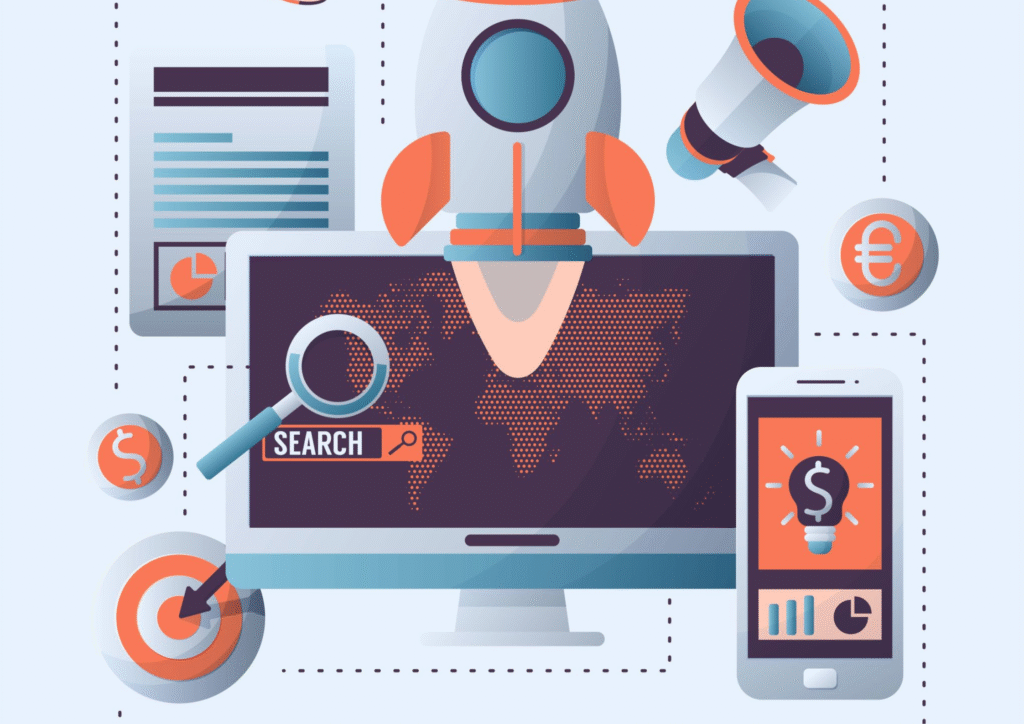In today’s fast-paced digital world, businesses of all sizes are turning to online channels to reach their audience—and that’s where digital marketing comes in. But what is digital marketing exactly? It’s the use of the internet, digital technologies, and online platforms to promote products, services, or brands to a targeted audience. From websites and social media to email campaigns and search engine optimization, digital marketing offers measurable, cost-effective, and scalable strategies that help businesses grow in a competitive landscape.

Digital marketing refers to the promotion of products or services using digital channels such as websites, social media, search engines, mobile apps, email, and more. It’s about reaching the right audience at the right time—online.
Unlike traditional marketing methods, digital marketing offers real-time data, precise targeting, and scalable results, making it one of the most cost-effective ways to grow a business.
Sure! Here’s a rewritten version of your content with the keyword “what is digital marketing” naturally integrated throughout the text:
What is Digital Marketing?
Digital marketing refers to the use of online channels and strategies to promote products or services and connect with audiences. It’s a dynamic field that combines data, technology, and creativity to drive results. If you’re wondering what is digital marketing in practice, here are the core components that define it today:
1. Search Engine Optimization (SEO)
A key pillar of digital marketing, SEO involves optimizing your website to rank higher on search engines like Google. This includes keyword research, high-quality content creation, and building backlinks. It’s all about increasing organic traffic by being more visible in search results.
2. Content Marketing
Still asking what is digital marketing? At its heart is content. Creating valuable content—whether blogs, videos, podcasts, or infographics—helps educate and engage your audience. Effective content marketing builds trust and guides people through the buyer’s journey.
3. Social Media Marketing
Digital marketing also includes leveraging platforms like Instagram, LinkedIn, Facebook, and TikTok. These channels allow brands to connect directly with users, share content, run ads, and foster brand loyalty.
4. Email Marketing
One of the most cost-effective digital strategies, email marketing helps you nurture leads and retain customers. Through newsletters, promotions, and automated workflows, it’s a powerful tool for relationship-building.
5. Pay-Per-Click Advertising (PPC)
Another way to understand what is digital marketing is through PPC campaigns. These paid ads appear on search engines and social platforms, and you’re charged only when someone clicks—making them measurable and controllable for lead generation.
6. Affiliate & Influencer Marketing
By partnering with influencers or affiliates who have dedicated followings, brands can expand reach and gain trust quickly. It’s a modern take on word-of-mouth, driven by relationships and audience alignment.
7. Marketing Automation & CRM
Digital marketing isn’t just about reach—it’s about efficiency. Automation tools and CRM platforms help businesses deliver personalized experiences at scale and track customer behavior for better results.
🚀 What’s Coming Next in Digital Marketing?
- AI for Content Creation: Tools like ChatGPT speed up content production—just remember to add a human touch.
- Search Beyond Google: Platforms like TikTok and Reddit are becoming search engines in their own right.
- Zero-Party Data: Users want control over their data—collect what they willingly provide.
- AR Shopping: Virtual try-before-you-buy experiences are reshaping ecommerce.
- Web3 & Decentralization: Still emerging, but opening new doors for ownership and privacy.
Understanding what is digital marketing today means keeping up with both foundational strategies and emerging trends. It’s not just about being online—it’s about being smart, agile, and audience-focused.
Would you like this turned into a presentation or infographic?

